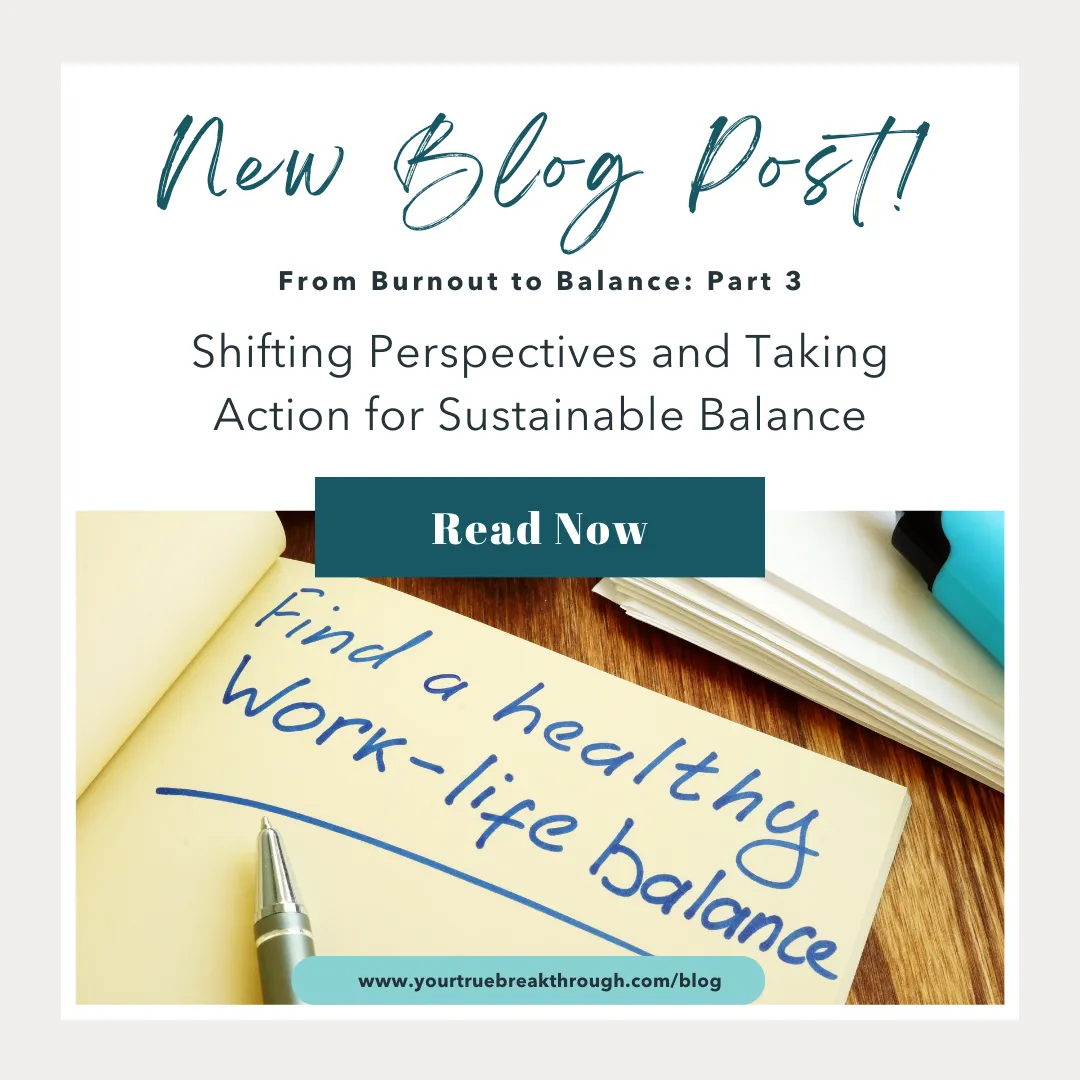Blog

From Burnout to Balance: Part 3 - Shifting Perspectives and Taking Action for Sustainable Balance
Welcome back to our series on transitioning from burnout to balance. So far, we've explored recognizing burnout signs, the importance of emotional processing, and the role of self-care in recovery. In this third part, we'll focus on the power of shifting perspectives and taking decisive action to achieve sustainable balance.
Shift Your Perspective
Shifting your perspective is a crucial step in overcoming burnout and achieving a balanced work-life. Our mindset and assumptions significantly influence our experiences, including burnout and work-life balance. Reflecting on these can provide valuable insights into what needs to change. Here are some steps to help you shift your perspective:
Self-Reflection: Start by taking a moment to pause and reflect. This is a time to be honest with yourself about your current mindset and the assumptions you hold.
Identify Your Beliefs: What are the beliefs that guide your actions and decisions? These could be beliefs about your work, your capabilities, or your worth. Write them down to get a clear picture.
Determine Fixed Aspects: Among your beliefs, identify which aspects are fixed. These are the beliefs that are deeply ingrained and may be harder to change. For example, you might believe that you must work long hours to be successful, or that you can't say no to requests.
Identify Areas for Change: Now, look at your list of beliefs and identify which ones can be changed. These might be beliefs that are not serving you well or that are contributing to feelings of burnout.
Develop a Plan for Change: Once you've identified areas for change, develop a plan to shift these beliefs. This could involve challenging negative self-talk, seeking support from a coach or therapist, or practicing mindfulness exercises.
Buffer the Impact: Understanding your fixed and changeable beliefs can help buffer the negative impact of even the inflexible aspects. For example, if you can't change your work hours, you might be able to change your belief about what those hours mean for your personal life.
Remember, shifting your perspective is a process, not a one-time event. Be patient with yourself as you navigate this journey.
Prioritization and Delegation: Mastering the Art of Letting Go
When exhaustion sets in, it's often a signal that we're trying to do too much. The key to managing this is through effective prioritization and delegation. Here's how you can master this art:
Identify Critical Tasks: The first step is to identify which tasks are critical to your role or project. These are tasks that require your specific skills and expertise and cannot be easily done by others. For example, if you're a project manager, critical tasks might include strategic planning and decision-making.
Determine Delegable Tasks: Once you've identified your critical tasks, look at what's left. These are tasks that can potentially be delegated. They might be tasks that are time-consuming but don't necessarily require your specific skills, such as administrative tasks or routine project updates.
Find the Right People: Delegation is not just about offloading tasks; it's about finding the right person for the job. Consider the skills, experience, and workload of your team members. Who has the capacity to take on more work? Who has the right skills for the task?
Trust and Let Go: Delegation requires trust. You need to trust that the person you're delegating to is capable of doing the job. This can be difficult, especially if you're used to doing everything yourself. But remember, delegation is not a sign of weakness. It's a sign of a good leader.
Provide Clear Instructions and Expectations: When you delegate a task, make sure the person understands what's expected of them. Provide clear instructions, deadlines, and any necessary resources. This will help ensure the task is done correctly and on time.
Follow Up, But Don't Micromanage: It's important to follow up on delegated tasks, but avoid micromanaging. Give the person space to complete the task in their own way. This not only empowers them but also frees up your time to focus on your critical tasks.
By mastering the art of prioritization and delegation, you can reduce your workload, manage your energy better, and create a more balanced and productive work environment.
Creating Efficient Systems: Your Roadmap to Less Stress
After shifting your perspective, the next step is to take action. One of the most impactful actions you can take is to change inefficient systems. This proactive step can significantly reduce stress and prevent burnout. Here are some strategies to help you create more efficient systems:
Improve Workflows: Analyze your current workflows and identify areas of inefficiency. Are there steps that can be eliminated or streamlined? Are there bottlenecks that slow down the process? By improving your workflows, you can save time and reduce stress.
Automate Repetitive Tasks: Automation can be a game-changer when it comes to efficiency. Look for tasks that are repetitive and can be automated. This could be anything from scheduling social media posts to automating email responses. By automating these tasks, you can free up time to focus on more important tasks.
Set Boundaries Around Work Hours: One of the major contributors to burnout is the blurring of boundaries between work and personal time. Set clear boundaries around your work hours and stick to them. This could mean not checking emails after a certain time or ensuring you take regular breaks throughout the day.
Prioritize and Delegate: As discussed earlier, learning to prioritize tasks and delegate effectively can significantly reduce your workload and stress levels. Focus on what's most important and let go of tasks that can be handled by others.
Seek Long-Term Solutions: Rather than looking for quick fixes, seek long-term solutions that address the root cause of the problem. This could involve investing in training to improve skills, hiring additional staff to manage workload, or implementing new technology to improve efficiency.
Remember, creating efficient systems is not a one-time event but an ongoing process. It requires regular review and adjustment to ensure it continues to meet your needs and contributes to a balanced and fulfilling professional life.
If you'd like to learn more about Mindset Coaching or Hypnotherapy and how it can support your journey, book your complimentary 30-min consultation for a personalized recommendation.
As we continue this series, we'll delve deeper into strategies for maintaining balance and preventing burnout. Stay tuned for Part 4, "Nurturing Professional Growth and Connections," where we'll explore the importance of professional development and building strong connections in sustaining balance in your professional life.
Blog

From Burnout to Balance: Part 3 - Shifting Perspectives and Taking Action for Sustainable Balance
Welcome back to our series on transitioning from burnout to balance. So far, we've explored recognizing burnout signs, the importance of emotional processing, and the role of self-care in recovery. In this third part, we'll focus on the power of shifting perspectives and taking decisive action to achieve sustainable balance.
Shift Your Perspective
Shifting your perspective is a crucial step in overcoming burnout and achieving a balanced work-life. Our mindset and assumptions significantly influence our experiences, including burnout and work-life balance. Reflecting on these can provide valuable insights into what needs to change. Here are some steps to help you shift your perspective:
Self-Reflection: Start by taking a moment to pause and reflect. This is a time to be honest with yourself about your current mindset and the assumptions you hold.
Identify Your Beliefs: What are the beliefs that guide your actions and decisions? These could be beliefs about your work, your capabilities, or your worth. Write them down to get a clear picture.
Determine Fixed Aspects: Among your beliefs, identify which aspects are fixed. These are the beliefs that are deeply ingrained and may be harder to change. For example, you might believe that you must work long hours to be successful, or that you can't say no to requests.
Identify Areas for Change: Now, look at your list of beliefs and identify which ones can be changed. These might be beliefs that are not serving you well or that are contributing to feelings of burnout.
Develop a Plan for Change: Once you've identified areas for change, develop a plan to shift these beliefs. This could involve challenging negative self-talk, seeking support from a coach or therapist, or practicing mindfulness exercises.
Buffer the Impact: Understanding your fixed and changeable beliefs can help buffer the negative impact of even the inflexible aspects. For example, if you can't change your work hours, you might be able to change your belief about what those hours mean for your personal life.
Remember, shifting your perspective is a process, not a one-time event. Be patient with yourself as you navigate this journey.
Prioritization and Delegation: Mastering the Art of Letting Go
When exhaustion sets in, it's often a signal that we're trying to do too much. The key to managing this is through effective prioritization and delegation. Here's how you can master this art:
Identify Critical Tasks: The first step is to identify which tasks are critical to your role or project. These are tasks that require your specific skills and expertise and cannot be easily done by others. For example, if you're a project manager, critical tasks might include strategic planning and decision-making.
Determine Delegable Tasks: Once you've identified your critical tasks, look at what's left. These are tasks that can potentially be delegated. They might be tasks that are time-consuming but don't necessarily require your specific skills, such as administrative tasks or routine project updates.
Find the Right People: Delegation is not just about offloading tasks; it's about finding the right person for the job. Consider the skills, experience, and workload of your team members. Who has the capacity to take on more work? Who has the right skills for the task?
Trust and Let Go: Delegation requires trust. You need to trust that the person you're delegating to is capable of doing the job. This can be difficult, especially if you're used to doing everything yourself. But remember, delegation is not a sign of weakness. It's a sign of a good leader.
Provide Clear Instructions and Expectations: When you delegate a task, make sure the person understands what's expected of them. Provide clear instructions, deadlines, and any necessary resources. This will help ensure the task is done correctly and on time.
Follow Up, But Don't Micromanage: It's important to follow up on delegated tasks, but avoid micromanaging. Give the person space to complete the task in their own way. This not only empowers them but also frees up your time to focus on your critical tasks.
By mastering the art of prioritization and delegation, you can reduce your workload, manage your energy better, and create a more balanced and productive work environment.
Creating Efficient Systems: Your Roadmap to Less Stress
After shifting your perspective, the next step is to take action. One of the most impactful actions you can take is to change inefficient systems. This proactive step can significantly reduce stress and prevent burnout. Here are some strategies to help you create more efficient systems:
Improve Workflows: Analyze your current workflows and identify areas of inefficiency. Are there steps that can be eliminated or streamlined? Are there bottlenecks that slow down the process? By improving your workflows, you can save time and reduce stress.
Automate Repetitive Tasks: Automation can be a game-changer when it comes to efficiency. Look for tasks that are repetitive and can be automated. This could be anything from scheduling social media posts to automating email responses. By automating these tasks, you can free up time to focus on more important tasks.
Set Boundaries Around Work Hours: One of the major contributors to burnout is the blurring of boundaries between work and personal time. Set clear boundaries around your work hours and stick to them. This could mean not checking emails after a certain time or ensuring you take regular breaks throughout the day.
Prioritize and Delegate: As discussed earlier, learning to prioritize tasks and delegate effectively can significantly reduce your workload and stress levels. Focus on what's most important and let go of tasks that can be handled by others.
Seek Long-Term Solutions: Rather than looking for quick fixes, seek long-term solutions that address the root cause of the problem. This could involve investing in training to improve skills, hiring additional staff to manage workload, or implementing new technology to improve efficiency.
Remember, creating efficient systems is not a one-time event but an ongoing process. It requires regular review and adjustment to ensure it continues to meet your needs and contributes to a balanced and fulfilling professional life.
If you'd like to learn more about Mindset Coaching or Hypnotherapy and how it can support your journey, book your complimentary 30-min consultation for a personalized recommendation.
As we continue this series, we'll delve deeper into strategies for maintaining balance and preventing burnout. Stay tuned for Part 4, "Nurturing Professional Growth and Connections," where we'll explore the importance of professional development and building strong connections in sustaining balance in your professional life.




